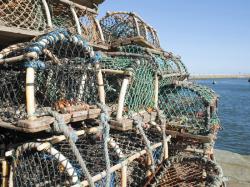New Study: Industry Conservation Ethic Proves Critical To Gulf Of Maine Lobster Fishery
January 29, 2018 | 3 min to read

PORTLAND, Maine — A new study, led by scientists at the Gulf of Maine Research Institute and colleagues at the University of Maine and NOAA, demonstrates how conservation practices championed by Maine lobstermen help make the lobster fishery resilient to climate change.
For generations, lobstermen in Maine have returned large lobsters to the sea and have designed a special way of marking egg-bearing lobsters to give them further protection. This conservation culture distinguishes the Gulf of Maine fishery from southern New England, where fishermen have not historically taken the same steps to preserve large, reproductive lobsters.
The study, funded by the National Science Foundation and published in Proceedings of the National Academy of Sciences (PNAS), shows how warming waters and contrasting conservation practices contributed to simultaneous record landings in the Gulf of Maine fishery and population collapse in southern New England.
Led by Dr. Arnault Le Bris, the research team used advanced computer models to simulate the ecosystem under varying conditions, allowing them to understand the relative impacts of warming waters, conservation efforts, and other variables. Their results show that, while temperature change was the primary contributor to population changes, conservation efforts made a key difference in population resiliency.
IMPACTS OF WARMING
Over 30 years (1984-2014), ocean temperatures increased rapidly in both regions. Warming in both regions shifted optimal summer ocean temperatures northeast, causing the southern New England lobster population to decline and the Gulf of Maine population boom. The researchers estimate that, during this 30-year period, the Gulf of Maine population increased by 515%, while the southern New England population declined by 78%. Challenges associated with warmer temperatures include decreased survival of larval lobsters, increased incidence of shell disease, and increased predation.
IMPACTS OF CONSERVATION
The study shows how conservation efforts prepared the Gulf of Maine population for temperature changes. Researchers estimate that lobster population growth in the Gulf of Maine was more than double what it would have been without conservation measures. Model simulations revealed that, without conservation measures to protect large lobsters and reproductive females, lobster abundance in the Gulf of Maine would have increased by 242% instead of 515%.
Temperature changes were disastrous for the southern New England fishery, which was already near the southern range of American lobster. Additionally, the region's lack of protections on larger reproductive lobsters made the population less resilient to warmer waters. The model estimates that, even in the face of warming waters, more restrictive conservation methods would have limited the population decline from 78% to 57% over the 30-year period.
IN THE FUTURE
In the Gulf of Maine, the lobster fishery is vulnerable to future temperature increases. The researchers' population projections suggest that lobster productivity will decrease as temperatures continue to warm, but continued conservation efforts can mitigate the impacts of future warming.
While scientists expect lobster populations to decline from recent highs, the 30-year outlook for the Gulf of Maine fishery looks positive if conservation practices continue. In their 30-year projection, the researchers anticipate average populations similar to those in the early 2000s.
IMPLICATIONS
The results of this study demonstrate how widely-adopted fishery conservation measures can help fishing communities mitigate the effects of changing ocean conditions. American lobster is the most valuable fishery in both the U.S. and Canada, with a combined landed value of more than $1.5 Billion USD in 2016.
Lead author Arnault Le Bris, a Gulf of Maine Research Institute postdoctoral research associate at the time of the study, is now a Research Scientist at the Fisheries and Marine Institute of Memorial University in Newfoundland.
"This paper shows how climate and fisheries management are connected," says Dr. Le Bris. "Communities that embrace anticipatory conservation methods can continue to thrive in a warming ocean."
Dr. Le Bris' work builds on the lab's prior research on the impacts of warming on Atlantic cod, another key Gulf of Maine species. Dr. Andrew Pershing, Chief Scientific Officer at the Gulf of Maine Research Institute and co-author of this study, led a 2015 study that showed, like lobsters in southern New England, cod in the Gulf of Maine suffered a steep decline in the face of warming waters and inadequate conservation measures.
"The older generation of lobstermen who championed the current protections in the Gulf of Maine gave a tremendous gift to today's lobstermen" says Dr. Pershing. "As waters continue to warm, continued commitment to conservation is the key to the future of this fishery."
###
About the Gulf of Maine Research Institute (GMRI):
The Gulf of Maine Research Institute pioneers collaborative solutions to global ocean challenges. Located in Portland, ME, GMRI is dedicated to the resilience of the Gulf of Maine ecosystem and the communities that depend on it. For more information, visit http://www.gmri.org
Source: Gulf of Maine Research Institute (GMRI)
